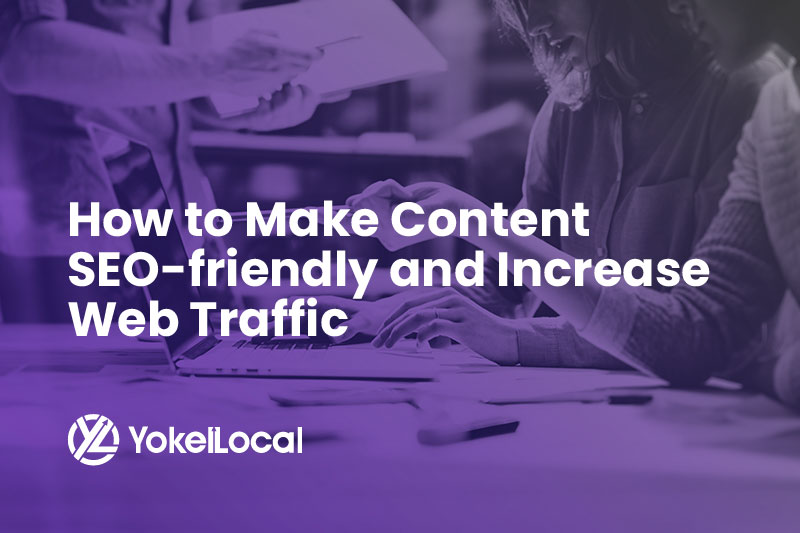Making the content on your site SEO-friendly is one of the best things you can do to increase your online visibility. While content is king, even the best article could go undiscovered if it’s not optimized for search engines. Without implementing SEO best practices in your content, you could lose web traffic to your business’s competitors that did. Learning how to optimize your content for search engines can help you make the most out of your marketing budget.
First Things First: What Is SEO-friendly Content?
Search engines, like Google, use algorithms to determine how websites and pieces of content will be ranked under different search terms or keywords. These algorithms analyze the content’s topic, quality, coding, and other factors to determine if and where it should show up in search results. Search engine optimization (or SEO) is the ongoing process by which people make changes to their websites to better conform to these algorithms, with the goal to increase overall rankings.
When writing SEO-friendly content, you’re trying to please two audiences: the humans who will read the content and the robots that will index it for search engines. The good news is that SEO-friendly content is also easier for human readers to navigate, which can increase engagement with your site and further improve its rankings. This is important, because the easier your website content, blog posts, industry articles, and press releases are to read, the more people will share the content, increasing awareness for your business and improving its image.
How to Make Content SEO-friendly
Take the following steps to help your content rank better on search engines:
First, Perform Keyword Research
Do you know what keywords your website visitors are searching for? Do you know what keywords you want to rank first for on Google, but they’re occupied by your competitors? By conducting keyword research, you can find out what keywords your customers and competitors are using, the competition to rank for each, and which are the best ones for you to target. Once you have this information, you can make changes to your site that make it easier to be found for those keywords.
Use the Keywords
Once you have identified the keywords you want to rank for, you can use them to rewrite your website content or use a keyword as the focal point for a blog post. Plug keywords into titles, subheadings, metadata, title tags, and alt tags. Try to use your main keyword a few times in your text, but make sure the keyword frequency and keyword density are relatively low. If a keyword is in a piece of content or on a web page too many times, search engines may penalize it for keyword stuffing.
Write for Humans
All content must be written for humans, meaning that it needs to be informative, engaging, and easy to understand. If your content is lackluster, readers will quickly exit your site after clicking, reducing the average time on page they spend and negatively impacting your rankings. They also won’t explore your site, which can increase your site’s bounce rate. If people aren’t reading your content, enjoying your content, and sharing your content, then SEO is a moot point.
Write Longer Pieces of Content
Longer pieces of informative, engaging content tend to perform better than shorter ones on search engines. Articles with higher word counts can increase the average time on page visitors spend and may lower the bounce rate, both of which can improve a page’s rankings. High-quality content can also serve as a reference point for other articles and may attract backlinks from high-ranking sites, sending a bit of “link juice” to improve your own page’s ranking. Longer pieces can also explore a topic more completely, making it more likely that it gets shared due to its thoroughness.
Use Multimedia
Multimedia such as infographics, images, and videos can keep visitors on a page longer, which can lead search engines to improve its ranking. Each image also has a label for the search engine that is read by its spiders that crawl and index your site, otherwise known as an alt tag. By creating keyword-rich alt tags, you can give more information about your page to the spiders, which can be used to improve your page’s rankings. Visually-stunning content is also more likely to go viral, which can bring in more visitors and quality backlinks.
Include Backlinks
A backlink is simply a link from one page to another and may be found embedded within the content, an image, or as a standalone feature. Pages that receive backlinks are seen by search engines and website visitors as relevant sources and receive a boost in their authority, relative to other pages for similar subjects. The more quality backlinks a page receives, the greater its authority is on a search engine. This can improve its overall rankings in searches, as it’s perceived by the search engine to be a quality source of information.
Don't Ignore Metadata
Metadata refers to information about your site embedded in its HTML code that’s meant for search engine spiders. This conveys important information about your site that spiders may use to determine how to rank it. The meta description of a piece of content is meant for human readers and likely doesn’t affect its ranking directly, but a well-written one will catch the reader’s attention and entice them to click on it.
Making your content SEO-friendly is a great first step to take to improve your business’s online exposure. It can also open the door to gaining the trust of more potential customers, who may be more likely to convert when they see you as a trusted resource. If you're looking for more helpful tips to increase SEO and domain authority, check out our article on how to rank your website higher on Google. If you need help with SEO services, our expert team is here to assist you!
SEO-friendly content is just one component to growing traffic and getting customers. Use our 6-step framework to help build a successful inbound strategy to get the right people to your website and get them to convert.














